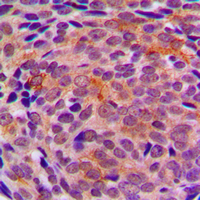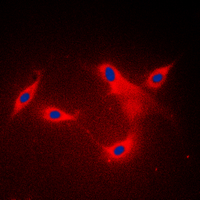Anti-LYPLA1 Antibody
Rabbit polyclonal antibody to LYPLA1
- SPECIFICATION
- CITATIONS
- PROTOCOLS
- BACKGROUND

Application
| WB, IF/IC, IHC |
|---|---|
| Primary Accession | O75608 |
| Other Accession | P97823 |
| Reactivity | Human, Mouse, Rat, Rabbit |
| Host | Rabbit |
| Clonality | Polyclonal |
| Calculated MW | 24670 Da |
| Gene ID | 10434 |
|---|---|
| Other Names | APT1; LPL1; Acyl-protein thioesterase 1; APT-1; hAPT1; Lysophospholipase 1; Lysophospholipase I; LPL-I; LysoPLA I |
| Target/Specificity | KLH-conjugated synthetic peptide encompassing a sequence within the center region of human LYPLA1. The exact sequence is proprietary. |
| Dilution | WB~~WB (1/500 - 1/1000), IH (1/100 - 1/200), IF/IC (1/100 - 1/500) IF/IC~~N/A IHC~~1:100~500 |
| Format | Liquid in 0.42% Potassium phosphate, 0.87% Sodium chloride, pH 7.3, 30% glycerol, and 0.09% (W/V) sodium azide. |
| Storage | Store at -20 °C.Stable for 12 months from date of receipt |
| Name | LYPLA1 |
|---|---|
| Synonyms | APT1, LPL1 |
| Function | Acts as an acyl-protein thioesterase (PubMed:19439193, PubMed:20418879). Hydrolyzes fatty acids from S-acylated cysteine residues in proteins such as trimeric G alpha proteins or HRAS (PubMed:20418879). Acts as a palmitoyl thioesterase that catalyzes depalmitoylation of proteins, such as ADRB2, KCNMA1 and SQSTM1 (PubMed:22399288, PubMed:27481942, PubMed:37802024). Acts as a negative regulator of autophagy by mediating palmitoylation of SQSTM1, decreasing affinity between SQSTM1 and ATG8 proteins and recruitment of ubiquitinated cargo proteins to autophagosomes (PubMed:37802024). Acts as a lysophospholipase and hydrolyzes lysophosphatidylcholine (lyso-PC) (PubMed:19439193). Also hydrolyzes lysophosphatidylethanolamine (lyso- PE), lysophosphatidylinositol (lyso-PI) and lysophosphatidylserine (lyso-PS) (By similarity). Has much higher thioesterase activity than lysophospholipase activity (PubMed:19439193). Contributes to the production of lysophosphatidic acid (LPA) during blood coagulation by recognizing and cleaving plasma phospholipids to generate lysophospholipids which in turn act as substrates for ENPP2 to produce LPA (PubMed:21393252). |
| Cellular Location | Cytoplasm. Cell membrane. Nucleus membrane. Endoplasmic reticulum. Note=Shows predominantly a cytoplasmic localization with a weak expression in the cell membrane, nuclear membrane and endoplasmic reticulum. |
| Tissue Location | Platelets.. |

Thousands of laboratories across the world have published research that depended on the performance of antibodies from Abcepta to advance their research. Check out links to articles that cite our products in major peer-reviewed journals, organized by research category.
info@abcepta.com, and receive a free "I Love Antibodies" mug.
Provided below are standard protocols that you may find useful for product applications.
Background
KLH-conjugated synthetic peptide encompassing a sequence within the center region of human LYPLA1. The exact sequence is proprietary.
If you have used an Abcepta product and would like to share how it has performed, please click on the "Submit Review" button and provide the requested information. Our staff will examine and post your review and contact you if needed.
If you have any additional inquiries please email technical services at tech@abcepta.com.













 Foundational characteristics of cancer include proliferation, angiogenesis, migration, evasion of apoptosis, and cellular immortality. Find key markers for these cellular processes and antibodies to detect them.
Foundational characteristics of cancer include proliferation, angiogenesis, migration, evasion of apoptosis, and cellular immortality. Find key markers for these cellular processes and antibodies to detect them. The SUMOplot™ Analysis Program predicts and scores sumoylation sites in your protein. SUMOylation is a post-translational modification involved in various cellular processes, such as nuclear-cytosolic transport, transcriptional regulation, apoptosis, protein stability, response to stress, and progression through the cell cycle.
The SUMOplot™ Analysis Program predicts and scores sumoylation sites in your protein. SUMOylation is a post-translational modification involved in various cellular processes, such as nuclear-cytosolic transport, transcriptional regulation, apoptosis, protein stability, response to stress, and progression through the cell cycle. The Autophagy Receptor Motif Plotter predicts and scores autophagy receptor binding sites in your protein. Identifying proteins connected to this pathway is critical to understanding the role of autophagy in physiological as well as pathological processes such as development, differentiation, neurodegenerative diseases, stress, infection, and cancer.
The Autophagy Receptor Motif Plotter predicts and scores autophagy receptor binding sites in your protein. Identifying proteins connected to this pathway is critical to understanding the role of autophagy in physiological as well as pathological processes such as development, differentiation, neurodegenerative diseases, stress, infection, and cancer.




